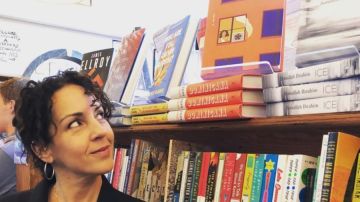Author Angie Cruz Touches on Immigration, Identity, and Colorism in New Novel ‘Dominicana’
As she made her way passed Barnes and Noble on 183rd st in Manhattan, writer Angie Cruz she took a quick glance at the window and realized an interesting title: How the Garcia Girls Lost Their Accents by Julia Alvarez

As she made her way passed Barnes and Noble on 183rd st in Manhattan, writer Angie Cruz she took a quick glance at the window and realized an interesting title: How the Garcia Girls Lost Their Accents by Julia Alvarez. Cruz shared with HipLatina her initial thoughts,“ What? Garcia? Alvarez? I went in and found out she was Dominican, forget about it,” she says. “It taught me that if I ever had a story to tell it can go in a book, that I didn’t have to be a white man or a dead white man.” Turns out Cruz had a few stories to tell, first in her debut as an author in 2001 for Soledad later publishing Let It Rain in 2005. She is now on her third book titled Dominicana.
The book centers around the life change of Ana Cancion, a Fifteen-year-old native Dominican girl who marries a man twice her age in search of financial security for her family. The title is symbolic to both Ana and the ceramic doll she comes to name “Dominicana.” Emigrating to the U.S with no understanding of the language and little knowledge of the political turmoil in the states, the reader follows Ana’s journey — one filled with questioning, domestic abuse, and discovery as the book highlights the various experiences of Dominican immigrants in the mid-60s.
I speak to Cruz the day after Jerrel Jerome’s big Emmy win. She is filled with excitement and joy. ”I was thinking about how it’s the same day that Dominicana was reviewed in the New York Times and my name was on the cover and Acevedo is on the bestseller list.” This was also the day after Bachatero Romeo Santos made history as the first Latin artist to headline the Metlife Stadium.
“This is a really good day for Dominicans,” she says. “There’s a scene in my book in which my character Ana is looking for Dominicans in the newspapers and I think there’s something about raza pride — when one of us is doing well we all feel hopeful and inspired.”
https://www.instagram.com/p/B32jJC0BgeT/
There is no doubt that we are currently in a moment. It’s not just Jarrel Jerome expressing his Afro-Dominican pride and placing it front and center moments after winning or Romeo Santos making numbers — he’s been making numbers for years. It’s that for decades POC were made to believe they weren’t a valuable market. “People usually think, where is the market for a book about a Dominican young woman or a movie about Latinos? We are still so underrepresented in Hollywood. In the book industry, there’s this like lack of awareness of our buying power and how we could really show up if they gave us the opportunity to show up,” Cruz says.
She speaks from her own experience. The author traveled to and from the island throughout her formative years. “I didn’t grow up in a house full of books. The first major book for me was the Encyclopedia [collection] that my mother had subscribed to. Everyone in the building would use that encyclopedia.” Dominicana is very loosely based on her mother’s experience. While her mother did migrate to the U.S in the 70s and married a man twice her age, Angie’s father, Ana’s story was the story of many women. “It took me over a decade to write the book. Being that working-class Dominican women are largely under-documented, I leaned on interviews and people’s photo albums to pull together a story of Dominicans in New York City in 1965,” she says. In fact, Cruz started a digital archive on Instagram specifically highlighting Dominican women from the 50s to 80s.
Through research, Cruz realized the parallels in her interviews. “It’s the stories I collected from many women about immigration in the 60s and 70s,” she says. “The truth is, it came down to what I believed could have happened to a 15-year-old girl who is married to a man she doesn’t love for the good of her family. It would never be spoken of.” Cruz expressed that it happens to a lot of women. Many are being married off for opportunity and progress — it’s not the story of the 60s. It’s the story of now.
In the story, Ana is first proposed at age 11 by Juan, an entrepreneur who recently migrated to New York City. After years of writing letters to Juan (largely motivated and enforced by her mother), they marry when he’s 32 and she’s 15. “Juan is the ticket for all of us to eventually go to America,” she says at the beginning of the story. Her reality is nothing close to what is considered the American Dream, as she faces the abrupt transformation of Juan who presents his true colors: mentally and physically abusive, frugal, and manipulative.
As Ana fought for her rights in her household, people were also fighting for their rights politically. The political frenzy in the Dominican Republic and the whereabouts of Malcolm X are highlighted throughout the book. Race and colorism resurface throughout the different parts of the story, through a range of discriminatory scenarios, focusing on the preferential treatment of those with lighter skin tones.
https://www.instagram.com/p/B3PVMUNBfJO/
”I chose the 60s because it was the year the United States occupied D.R. and it’s the year Malcolm X was assassinated. I grew up across the street from the Audubon Ballroom where the assassination happened and I was interested in thinking about how Dominicans, recently arrived, were living in and with the civil rights movement,” Cruz says. “I also think that even if one says they are not political, everything, especially wars, and government, even if they are far away, have an impact on our lives, spirit, and heart.”
Overall, Cruz is hopeful readers will walk away with a deep connection once finishing Dominicana.” I think reading is a very personal experience. At the very least I hope that anyone who reads the book, especially women, feel seen or less alone in life,” she says. “Books have kept me company and I am grateful for books for helping me create new expansive maps for my own life.”

















